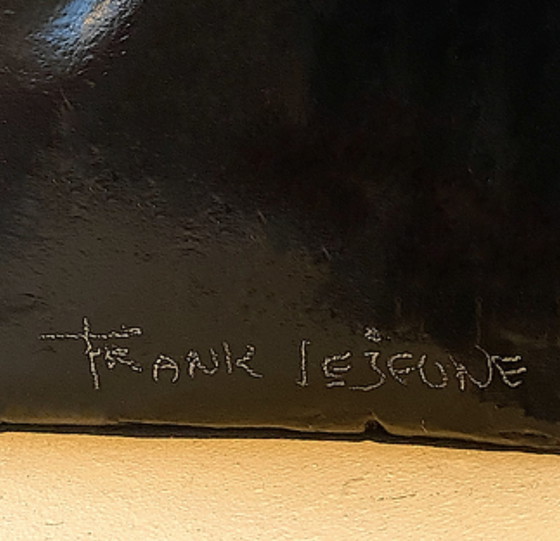Delivery from €39Buyer protectionAll items curated by Whoppah

Frank lejeune, abstract ceramic object
Professional seller:Verified seller€1,000,-€400,--60%Offer from €300,-
Item not as advertised, money back.All items are curated and 100% authenticHave it delivered hassle-free or pick it up yourselfShop only from Trusted Sellers
Professional seller: Verified seller
Vessem, NetherlandsView all items from this seller
After several decades of making two-dimensional work, I found a new challenge in ceramics. After playing with a material unknown to me for a year, clay, I was able to experience what is possible with this material and gradually adapt the behavior of the material.
With the design of the ceramic objects I went back to the period when I painted purely abstract, colored surfaces and shapes.
In the design of the sculptures I want to accentuate the spontaneity of the creation, the robust covering of the sculpture does not tolerate any traces of modelling.
With the painting in mainly primary colors I also refer to my paintings, with the contrast of the primary colors I want to enhance the dynamics.
Due to the many slits at the corners and on the other hand inhospitable parts of the images, as well as the desired colors, it is not possible to apply glaze, so I opted for gouache. Gouache has the desirable structure to cover the ceramic skin and not change the structure of the material.
The gouache is covered with a transparent acrylic layer for protection.
Frank lejeune, 1962 Northampton (Eng.) , is self-taught and has only been working as an independent artist since he was 30. He soon sold his first works of art and then had his first exhibition at the age of 33. In the years before his painting career, Frank Lejeune worked in business.
He filled his spare time with painting. One day the time came for Lejeune to free himself from the strict social patterns and chose an uncertain artist's existence.
"If I say that I have made my hobby my job, then that pretty much sums it up." Lejeune says with a smile, about this clichéd saying.
In the beginning, confirmation for his work from the outside was important. As he exhibited more often and began to sell his work regularly, this feeling gradually diminished.
"Actually, my work is difficult to place anywhere because I have never consciously had examples or struggled with a certain direction. Something that people do intensively at the academy..
I soon learned that if you're not an artist from the inside out, there's no academy that can make you one. They teach you how to handle your gift.
Lejeune's work is explosive. "It all happens very quickly. That's why I prefer to work with acrylic paint.. I can't work with oil paint because the drying process is so slow".
The crackle layers that arise in Lejeune's artworks are therefore inherent in the way in which he handles fast-drying acrylic paint. One sees plastically applied compositions in which the paint in thick layers is sometimes pressed directly from the tube onto the carrier.
Nature has always been an important source of inspiration, which means that his work sometimes has something landscape-like, or evokes associations with animals and plants. "I think the composition of the moment is the most important in my work!
Yet a work of art remains a solitary thing for me, with the result that a clear line in my oeuvre plays a subordinate role. I therefore experience exhibiting as a necessary evil.. not because I don't enjoy it, but because I feel I have to work serially. Of course your work develops and something changes all the time..
The process of painting itself serves as a source of inspiration for Lejeune, whereby a completed canvas can be the basis for a subsequent work.
In Lejeune's early work, one sees, among other things, multi-panels in which horizontal color compositions shoot over different panels with spontaneous force.
Later his work became more and more whimsical and horizontal line compositions gave way to angular and round motifs. The tension between color and form becomes more intense and overlapping color surfaces are created, which degenerate into almost mask-like scenes, sometimes covered with a transparent white layer of acrylic paint.
In 1987 he released his first screen print! I have always printed and distributed everything myself... every screen print is different because after printing I finish the work with paint and pastel pencil. The 'craft' aspect of printing gives Lejeune great pleasure.
Also characteristic are the mainly primary colors yellow, red and blue. "In my work I have always played around with these colors.
I am rarely satisfied with my work and the feeling that I have yet to do my best work always returns."
After several decades of making two-dimensional work, I found a new challenge in ceramics. After playing with a material unknown to me for a year, clay, I was able to experience what is possible with this material and gradually adapt the behavior of the material.
With the design of the ceramic objects I went back to the period when I painted purely abstract, colored surfaces and shapes.
In the design of the sculptures I want to accentuate the spontaneity of the creation, the robust covering of the sculpture does not tolerate any traces of modelling.
With the painting in mainly primary colors I also refer to my paintings, with the contrast of the primary colors I want to enhance the dynamics.
Due to the many slits at the corners and on the other hand inhospitable parts of the images, as well as the desired colors, it is not possible to apply glaze, so I opted for gouache. Gouache has the desirable structure to cover the ceramic skin and not change the structure of the material.
The gouache is covered with a transparent acrylic for protection.
Drs Genevieve Momma-Wehry
ConditionExcellentColorsPurple, Green, Blue, White, Red, Multi Color, Orange, Yellow, Black, PinkMaterialCeramicNumber of items1ArtistsFrank LejeuneFirst ownerYesHeight32 cmWidth43 cm





